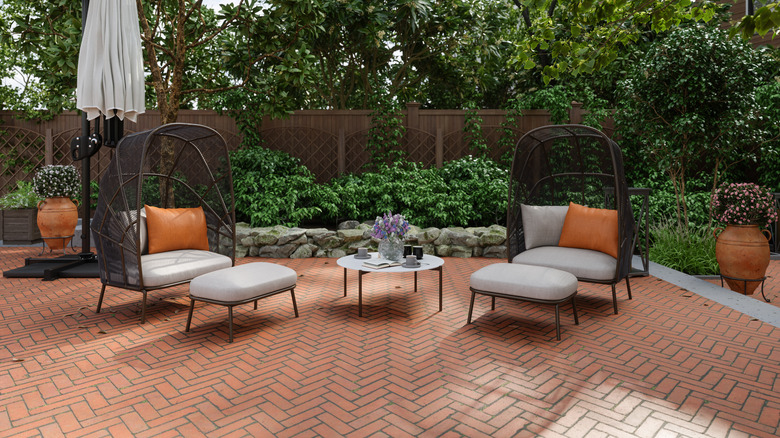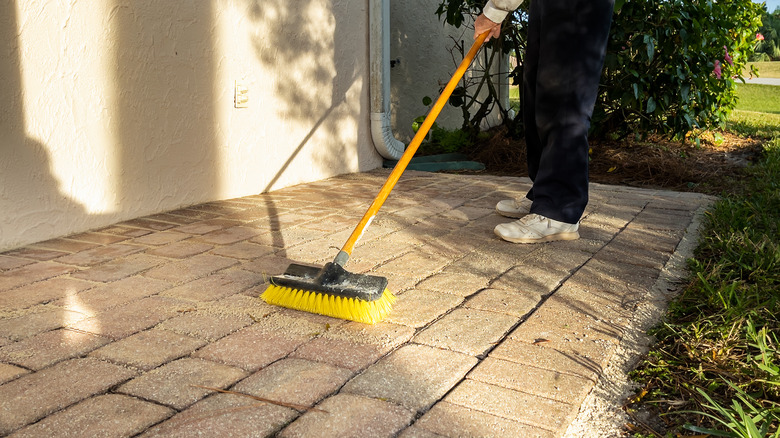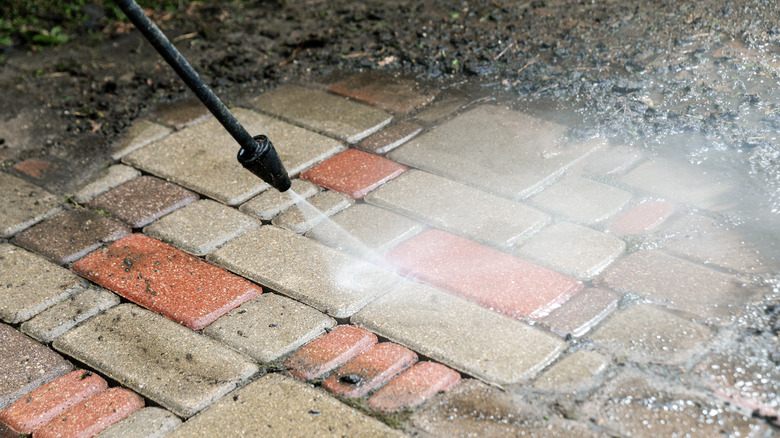The Best Way To Clean Brick Patio Pavers To Give Them A Much-Needed Refresh
Brick patio pavers can elevate your yard with their timeless, elegant look — until they get all grimy and weedy. Especially if your patio is shaded or full of plants, your brick pavers may be in serious need of a refresh, but the process isn't complicated. The best way to clean your patio pavers is to saturate them with water, scrub with a mild cleaning product, then rinse.
Compared to some other patio pavers, brick comes with many benefits. It's durable, sustainable, and easy to maintain and repair. You also don't need to deep clean very often, and you can get away with even less scrubbing if you frequently sweep. Once a year cleaning works well for shaded patios that don't dry out as often, and every few years is a good benchmark for sunny patios. You can also seal your backyard patio pavers to prevent future stains.
However, when it is time to clean, it's important to do it right. Brick is expensive, so you definitely don't want to damage it unnecessarily. A few simple products will get your brick pavers looking fresh.
Prep and pick your cleaning solution
There are a few different cleaning solutions that you can use to clean brick patio pavers, including plain hot water, hot water mixed with a mild surfactant such as dish soap, hot water mixed with white vinegar, or a store-bought cleaning product specifically formulated for brick. The first three options are safe for most brick pavers, but the latter option requires a bit more caution. Check with your paver manufacturer to make sure that your bricks are compatible with the cleaning product. Or, apply it to a small test area first to make sure that it doesn't cause any unwanted effects, such as staining.
To clean brick pavers by hand, you'll need a bucket to mix your cleaning solution in and a masonry cleaning brush (or any stiff brush that's not made with metal bristles). Alternatively, you can use a pressure washer if you have one. Just make sure to use very low pressure to avoid damaging the bricks, overly saturating them, or displacing too much sand.
Once you have all your cleaning materials ready, it's time to prepare the area for cleaning. Clear any objects out of the way, such as furniture or plants. You may also want to protect nearby landscaping, walls, or doors with a tarp, especially if you plan to use a cleaning product with chemicals that could cause damage to these items. Finally, clear the weeds from between the pavers and give the area a quick sweep.
Saturate, then scrub
The next step is to fully saturate the pavers with plain water. This step is essential: it helps prevent the brick from absorbing too much of the cleaning solution, which can produce a film or result in stains. After the pavers are soaking wet, you can apply the cleaning solution. Brush the pavers clean, working in one small area at a time and making sure not to let them dry out. Some store-bought cleaners require extra time to work. You can also repeat these steps if some areas need extra scrubbing. Afterward, rinse the area with water until the runoff is clear. Then allow the area to air dry.
This process often dislodges some sand despite your best efforts, so you can take this time to refill the joint spaces. Pour new sand that matches the old and sweep with a dry stiff-bristled brush, pushing it into the cracks. Then mist it with new water so it can set.
To tackle stains, first scrape off as much residue of the stain as you can without damaging the brick. Then scrub with a stiff bristle brush and scouring powder. For moss or lichen, a bleach solution or fungicide should work. If your pavers have severe staining or damage, call a professional for help.


